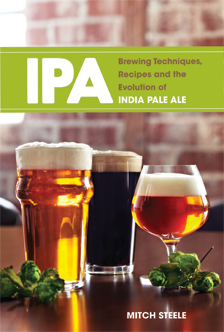 In Poland, they pronounce it eye-pa, as in “I brewed an American eye-pa.”
In Poland, they pronounce it eye-pa, as in “I brewed an American eye-pa.”
In Spain, it’s ee-pa.
The initials for the style otherwise known as India pale ale have taken on an international life of their own. The full title of the newest book from Brewers Publications is IPA: Brewing Techniques, Recipes and the Evolution of India Pale Ale, but look at the cover and repeat after author Mitch Steele: I-P-A.
Steele, whose day job is head brewer at Stone Brewing Co., spent more than three years working on the book. When he started IPA was the fourth best-selling craft beer style—now it’s number one. IPA sales in the U.S. increased 40 percent in 2011 and are on pace to grow that much again in 2012.
This book could hardly have arrived at a better time. Steele speaks to beer drinkers who want to know more about IPA, to homebrewers, and to commercial brewers alike. That’s because he’s all of those. In the introduction he confesses, “I look back and realize I’ve become more of an IPA geek than I was.”
As a result, when he writes about the history of India pale ale in the first half of the book, he not only sets the story straight, but includes essential brewing details. And let’s be honest, American brewers are often guilty of repeating the myriad of myths about India pale ale. Because the book is so rich in information, breweries may even end up correcting the errors in history on their bottle labels and elsewhere.
It’s an un-rushed history, illustrated throughout with vintage drawings and photos. He also takes time to digress, for instance telling the story of how the Cascade hop quite nearly did not make it from breeding plots to farmers’ fields, the rhetorical question being what that would have meant for the future of American hop-centric ales.
* Stan Hieronymus has more to share in the History of Beer section.
Conversely, the closing chapters are thick with information about ingredients and process, making it clear this is a brewing book. Nonetheless, it is presented in a way that an enthusiast who won’t bookmark page after page and otherwise “geek out” over forty-eight recipes will gain a full appreciation of why Fuller’s 1897 IPA and Fathead’s Headhunter IPA taste so different.
In the course of his research Steele accumulated page after page of data, both old (analysis of various IPAs from the 1800s and first half of the twentieth century) and new (analysis of various craft-brewed IPAs by region, including IBUs for some of the biggest and baddest IPAs around).
He also identified the real story: “IPA is a beer style that has gone through many drastic changes throughout its history,” he writes at the outset. “There are at least three distinct versions of the beer.” Just as important, he has figured out how to tell that story. The only thing not clear is which shelf to put IPA: Brewing Techniques, Recipes and the Evolution of India Pale Ale on. Does it go on the one with technical brewing journals or the one with beer history books? Maybe both.
Stan Hieronymus has traveled the United States many times over while writing about beer for numerous publications. He’s author of seven books, including Brew Like a Monk and Brewing With Wheat.
Brewers Publications | Kristi Switzer | kristi@brewersassociation.org | members.brewersassociation.org/store/

 Resource Hub
Resource Hub